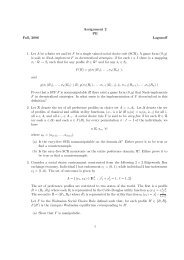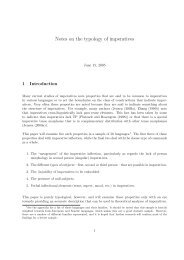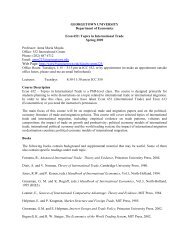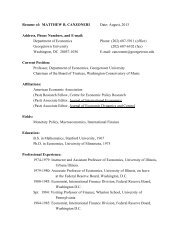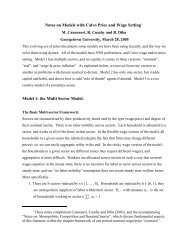Notes on Kehoe Perri
Notes on Kehoe Perri
Notes on Kehoe Perri
You also want an ePaper? Increase the reach of your titles
YUMPU automatically turns print PDFs into web optimized ePapers that Google loves.
<str<strong>on</strong>g>Notes</str<strong>on</strong>g> <strong>on</strong> <strong>Kehoe</strong> <strong>Perri</strong>J<strong>on</strong>athan HeathcoteOctober 10, 2002There is nothing in these notes that is not in <strong>Kehoe</strong> <strong>Perri</strong> NBER WorkingPaper 7820 or <strong>Kehoe</strong> and <strong>Perri</strong> Ec<strong>on</strong>ometrica 2002. However, I have gatheredall the equati<strong>on</strong>s together, and added a few more steps in the computati<strong>on</strong>s inplaces.1 ModelPlanner’s objective"X∞ Xmax λ 1 β t π(s t )U ¡ c 1 (s t ),l 1 (s t ) ¢ X∞ X+ λ 2 β t π(s t )U ¡ c 2 (s t ),l 2 (s t ) ¢#t=0 s t t=0 s tResource c<strong>on</strong>straintsX £ci (s t )+k i (s t ) ¤ = X£F (ki (s t−1 ),A i (s t )l i (s t )) + (1 − δ)k i (s t−1 ) ¤ ∀t, s ti=1,2i=1,2Enforcement c<strong>on</strong>straints∞X Xr=ts r β r−t π(s r |s t )U ¡ c i (s r ),l i (s t ) ¢ ≥ V i (k i (s t−1 ),s t ) ∀i, t, s tAutarky problem∞X XV i (k i (s t−1 ),s t )=max β r−t π(s r |s t )U(c i (s r ),l i (s r ))r=t s rsubject toc i (s r )+k i (s r ) ≤ F (k i (s r−1 ),A i (s r )l i (s r )) + (1 − δ)k i (s r−1 )∀r, s r1
Lagrangian for planner’s problem∞Xmax λ X1 β t π(s t )U ¡ c 1 (s t ),l 1 (s t ) ¢ X∞ X+ λ 2 β t π(s t )U ¡ c 2 (s t ),l 2 (s t ) ¢{c i (s t ),l i (s t ),k i (s t )}t=0 s t t=0 s t∞X X+ β t π(s t ) X "X ∞Xµ i (s t ) β r−t π(s r |s t )U ¡ c i (s r ),l i (s t ) ¢ #− V i (k i (s t−1 ),s t )t=0 s ti=1,2 r=t s⎡r ⎤∞X X+ β t π(s t )γ(s t ) ⎣ X £F (ki (s t−1 ),A i (s t )l i (s t )) + (1 − δ)k i (s t−1 ) ¤ − X £ci (s t )+k i (s t ) ¤ ⎦t=0 s t i=1,2i=1,2Now note that π(s r )=π(s r |s t )π(s t ).Note also that there is a ’partial summati<strong>on</strong> formula of Abel’ which pointsout that∞P X∞β t µ t β r−t Pu(c r )= ∞ β t M t u(c t )t=0r=tt=0whereM t = M t−1 + µ t ,M −1 =0Lets apply this to the Lagrangianmax + X∞ X{c i (s t ),l i (s t ),k i (s t )}t=0 s t+ resource c<strong>on</strong>straintsXβ t π(s t ) £ M i (s t )U ¡ c i (s t ),l i (s t ) ¢ − µ i (s t )V i (k i (s t−1 ),s t ) ¤i=1,2whereM i (s t )=M i (s t−1 )+µ i (s t )M i (s −1 )=λ iFor some reas<strong>on</strong> KP instead choose to write choose instead to write∞X X Xmaxβ t π(s t ) £ M i (s t−1 )U ¡ c i (s t ),l i (s t ) ¢ + µ i (s t ) £ U ¡ c i (s t ),l i (s t ) ¢ − V i (k i (s t−1 ),s t ) ¤¤{c i (s t ),l i (s t ),k i (s t )}t=0 s t i=1,2+ resource c<strong>on</strong>straints2 First order c<strong>on</strong>diti<strong>on</strong>s1. c i (s t )β t π(s t )M i (s t−1 )U ic (s t )+β t π(s t )µ i (s t )U ic (s t ) − β t π(s t )γ(s t )=0Combining the FOCs for the two countries, we getU 1c (s t ) ¡ M 1 (s t−1 )+µ 1 (s t ) ¢ = U 2c (s t ) ¡ M 2 (s t−1 )+µ 2 (s t ) ¢2
orU 1c (s t )U 2c (s t ) = M 2(s t−1 )+µ 2 (s t )M 1 (s t−1 )+µ 1 (s t )2. l i (s t )β t π(s t )M i (s t )U il (s t )+β t π(s t )µ i (s t )U il (s t ) − β t π(s t )γ(s t )F ilCombining this with the FOC for c i (s t ) gives3. k i (s t )U il (s t )(M i (s t )+µ i (s t ))F il= U ic (s t ) ¡ M i (s t )+µ i (s t ) ¢or U il(s t )F il= U ic (s t )−β t π(s t )γ(s t )= β X t+1 π(s t+1 |s t )γ(s t+1 )[F ik +(1− δ)] − β X t+1 π(s t+1 |s t )µ i (s t+1 )V ik (k i (s t ),s t+1 )s t+1 s t+1U ic (s t ) ¡ M i (s t−1 )+µ i (s t ) ¢= β X π(s t+1 |s t ) £ U ic (s t ) ¡ M i (s t )+µ i (s t+1 ) ¢ [F ik +(1− δ)] − µ i (s t+1 )V ik (k i (s t ),s t+1 ) ¤s t+1U ic (s t )=β X ·π(s t+1 |s t ) U ic (s t ) M i(s t+1 )M i (s t [F ik +(1− δ)] − µ i(s t+1 ¸))M i (s t ) V ik(k i (s t ),s t+1 )s t+1As in the simpler Kocherlakota ec<strong>on</strong>omy, <strong>Kehoe</strong> and <strong>Perri</strong> then define somenew variablesv i (s t )= µ i(s t )M i (s t )z(s t )= M 2(s t )M 1 (s t )ThenM i (s t )= M i(s t−1 )1 − v i (s t )and thusz(s t )= 1 − v 1(s t )1 − v 2 (s t ) z(st−1 )Now the first order c<strong>on</strong>diti<strong>on</strong>s for c<strong>on</strong>sumpti<strong>on</strong> and capital can be rewrittenasU 1c (s t )U 2c (s t ) = M 2(s t )+µ 2 (s t )M 1 (s t−1 )+µ 1 (s t ) = z(st )= 1 − v 1(s t )1 − v 2 (s t ) z(st−1 )3
andU ic (s t )=β X ·π(s t+1 |s t ) U ic (s t 1)1 − v i (s t+1 ) [F ik +(1− δ)] − v i(s t+1 ¸)1 − v i (s t+1 ) V ik(k i (s t ),s t+1 )s t+1<strong>Kehoe</strong> and <strong>Perri</strong> focus <strong>on</strong> Markov shocks, so that π(s t |s t−1 )=π(s t |s t−1 ).Then look for decisi<strong>on</strong> rules c i (x t ),l i (x t ),k i (x t ) together with policy rulesfor z(x t ) and v i (x t ) where the state x t = ¡ z(s t−1 ),k 1 (s t−1 ),k 2 (s t−1 ),s t¢. Thusthis is the same state space we used to solve the Kocherlakota model, exceptthat k 1 (s t−1 ) and k 2 (s t−1 ) have been added.3 Computati<strong>on</strong> procedureLet x =(z,k 1 ,k 2 ,s) be the state (note that the notati<strong>on</strong> is a bit c<strong>on</strong>fusing, sincethe understanding is that z, k 1 and k 2 are inherited from the previous period,and do not depend <strong>on</strong> the current state s).Define also value functi<strong>on</strong>sW i (x) =U(c i (x),l i (x)) + β X s 0π(s 0 |s)W i (x)Define a grid X <strong>on</strong> the state space (i.e a three dimensi<strong>on</strong>al grid over thethree c<strong>on</strong>tinuous variables z, k 1 and k 2 for each possible (discrete) value for s.Guess © c 0 i (x),l0 i (x),k00 i (x),z00 (x),vi 0(x),W0 i (x)ª ∀x ∈ X. One good initialguess is the soluti<strong>on</strong> to the planning problem without enforcement c<strong>on</strong>straints.Note that these allocati<strong>on</strong>s corresp<strong>on</strong>d to the allocati<strong>on</strong>s that would emerge in adecentralized ec<strong>on</strong>omy with a complete set of asset markets and no enforcementproblems.Now procede to update the guess. Suppose, we are <strong>on</strong> the n th iterati<strong>on</strong> inupdating the vector of unknown functi<strong>on</strong>s, and suppose we are at point q in thegrid.First assume neither enforcement c<strong>on</strong>straint binds. Thus immediately v i (q) =0 and z 0 (q) =z.Compute (c i (q),l i (q),ki 0 (q)) (6 numbers) that satisfy1. The c<strong>on</strong>sumpti<strong>on</strong> leisure FOC for both agents (2 equati<strong>on</strong>s)U il (q)F il (q) = U ic(q)2. The expressi<strong>on</strong> for z (1 equati<strong>on</strong>)U 1c (q)U 2c (q) = z0 (q)3. The world resource c<strong>on</strong>straint (1 equati<strong>on</strong>)X[c i (q)+ki(q)] 0 = X[F (k i (q),A i (q)l i (q)) + (1 − δ)k i (q)]i=1,2i=1,24
4. The FOCs for capital (2 equati<strong>on</strong>s)U c (c i (q),l i (q))= β X ·π(s0|s) U c (c n−1i (x 0 ),lin−1s0(x 0 )) F k(ki 0(q),A(s0 )l n−1i(x 0 )) + (1 − δ)1 − v n−1−i(x 0 )Note that, to evaluate c i ,l i and v i in the next period, we use the oldguesses for the decisi<strong>on</strong> rules policy functi<strong>on</strong>s (superscript n − 1). The’unknowns’ in this equati<strong>on</strong> are c i (q), l i (q) and ki 0 (q). Note, however, thatalthough we use the old functi<strong>on</strong>s for next period variables, we do evaluatethem at the correct point: x 0 =(z 0 (q),k1(q),k 0 2(q),s 0 0 ) .Thus at this point we solve a system of 6 n<strong>on</strong>-linear equati<strong>on</strong>s in 6 unknowns.Then we check whether either of the two enforcement c<strong>on</strong>straints is violated.If neither is, we are d<strong>on</strong>e with this grid point.Alternatively suppose <strong>on</strong>e of the enforcement c<strong>on</strong>straints is violated (say the<strong>on</strong>e for country 1). Then we solve a different system of equati<strong>on</strong>s. Now we lookfor (c i (q),l i (q),k 0 i (q),v 1(q),z 0 (q)) (8 numbers) that satisfy1. The c<strong>on</strong>sumpti<strong>on</strong> leisure FOC for both agents (2 equati<strong>on</strong>s)2. The expressi<strong>on</strong> for z (1 equati<strong>on</strong>)U il (q)F il (q) = U ic(q)U 1c (q)U 2c (q) = z0 (q)3. The law of moti<strong>on</strong> for z (1 equati<strong>on</strong>)z0(q) = 1 − v 1(q)z14. The world resource c<strong>on</strong>straint (1 equati<strong>on</strong>)X[c i (q)+ki(q)] 0 = X[F (k i (q),A i (q)l i (q)) + (1 − δ)k i (q)]i=1,2i=1,25. The FOCs for capital (2 equati<strong>on</strong>s)U c (c i (q),l i (q))= β X ·π(s0|s) U c (c n−1i (x 0 ),lin−1s0(x 0 )) F k(ki 0(q),A(s0 )li n−1 (x 0 )) + (1 − δ)1 − vi n−1−(x 0 )6. The enforcment c<strong>on</strong>straint for country 1 is an equality (1 equati<strong>on</strong>)vn−1 i(x 0 ¸)1 − v n−1i(x 0 ) V ik(k0(q),s 0 )vn−1 i (x 0 ¸)1 − vi n−1 (x 0 ) V ik(k0(q),s 0 )U c (c i (q),l i (q)) + β X s 0π(s 0 |s)W n−1i (x 0 )=V i (k i ,s)5
Note that in equilibrium, if the planner is doing its job, it will not be thecase the both enforcement c<strong>on</strong>straints bind simultaneously.Once decisi<strong>on</strong> rules have been updated at <strong>on</strong>e point in the grid, we move tothe next point, and c<strong>on</strong>tinue until decisi<strong>on</strong> rules have been updated. Now (and<strong>on</strong>ly now) we can update the value functi<strong>on</strong>s, for each x ∈ X. For example, forx = qW ni (q) =U(c n i (q),l n i (q)) + β X s 0π(s 0 |s)Win−1 (x 0 (q))If the new value functi<strong>on</strong>s are cloes to the old for every x, we are d<strong>on</strong>e.Otherwise, we need to repeat the entire process.It is important the the initial guess for the value functi<strong>on</strong>s is uniformlygreater than or equal to the true value of the value functi<strong>on</strong>.6






